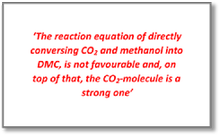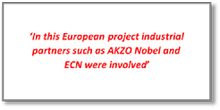 The aim of this thesis is to investigate the potential of membrane reactors for the direct conversion of CO2 into dimethyl carbonate (DMC). ‘The use of membrane reactors for this application is rather unexplored,’ Harro Mengers says.
The aim of this thesis is to investigate the potential of membrane reactors for the direct conversion of CO2 into dimethyl carbonate (DMC). ‘The use of membrane reactors for this application is rather unexplored,’ Harro Mengers says.
‘We studied several aspects including numerical simulations of different membrane reactors and the actual performance of the membranes being used. ‘Results show that the addition of a chitosan layer on top of sulfonated polyether ether ketone (SPEEK) membranes, enhances the water vapour permeations and improves the H2O/CO2 selectivity. In order to withstand high temperatures, the thermal stability of SPEEK membranes was studied by replacing the H+ cation by other cations.
The direct conversion of CO2 and methanol into DMC is a hard nut to crack, Harro Mengers explains. ‘The reaction equation is not favourable and, on top of that, the CO2-molecule is a strong one,’ he says.
Two types

Using water vapor selective catalytic membrane reactors for this conversion is an attractive idea, as the instant removal of reaction products (e.g. H2O) from the reaction mixture may enhance the conversion of CO2. Two types of reactors were compared: catalytic membrane reactors in which locations of reaction and separation coincide, and inert membrane reactors in which locations of reaction and separation do not overlap.
For the direct conversion of CO2 into DMC, numerical simulations and theoretical considerations propose the use of catalytic membrane reactors. ‘Careful integration of membrane and catalytic reactants is crucial here,’ Harro says.
Thermal stability

‘As high temperatures are prevalent in these membrane reactors, we tried to add mono-, di and even trivalent counter ions, resulting in strongly improved thermal stability up to 450-500 ºC. Interesting phenomena were observed alongside this research route: The forming of ionic crosslinks between these ions and SO3- groups, for example, can positively affect permeation performances, which are sometimes hindered.’
Techno-economic evaluation
After using a vast amount of experimental and numeric techniques - including Fourier Transform Infrared Spectroscopy, in collaboration with the Materials Science and Technology of Polymers led by professor Julius Vansco – Harro finished his thesis work with a techno-economic evaluation.

‘In this European project industrial partners such as AKZO Nobel and ECN were involved. Simulations show that the removal of water vapor is insufficient to stimulate the conversion. In order to purify this to required specifications in everyday practice in chemical industry, large size equipment and a substantial amount of energy (13.61 kWh/kg DMC) is required, which result in high investment and utility costs. Therefore future research on membrane reactors should focus on the selective removal of DMC instead of water to obtain higher DMC concentrations in the reactor effluent.’
Custom-oriented
At the moment Harro is appointed a process and sales engineer at HoST Systems in Enschede. Here he works on biomethane equipment converting compostable and organic waste.

‘The work is custom-oriented. Making bids and designing fabrication concepts are central in my job. Building factories is the reason I once decided to be a chemical engineer. I might miss my PhD work from time to time. Nevertheless, being forced to bring the project further by sheer self-motivation sometimes can be hard.’
‘Here at HoST solutions have to be found within limited periods of time, which induces one to go and find the right expertise and collaborations with colleagues, to work on solutions directly.’
